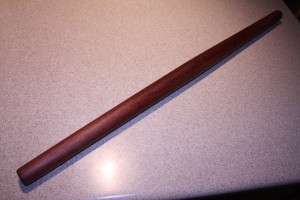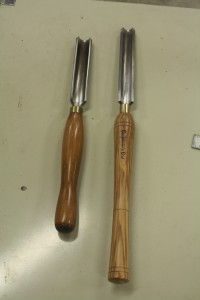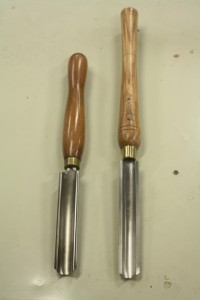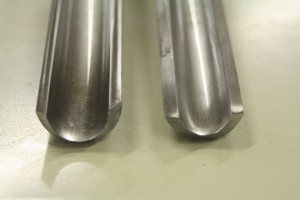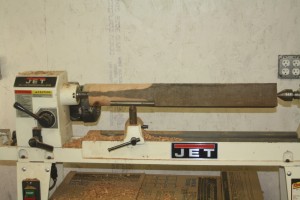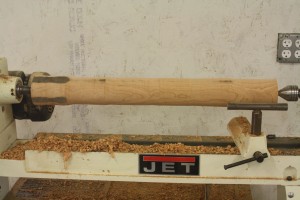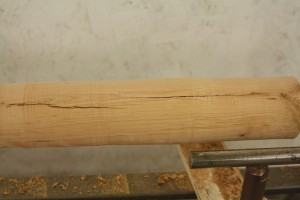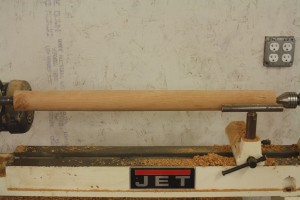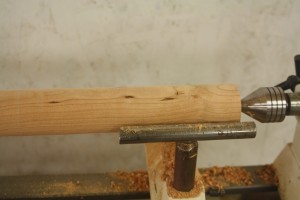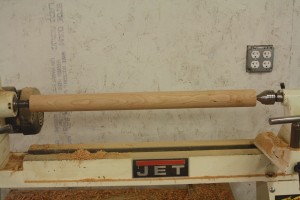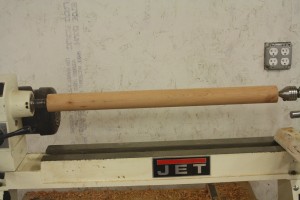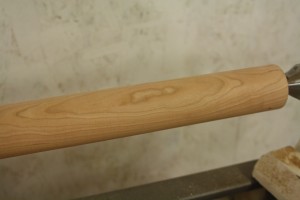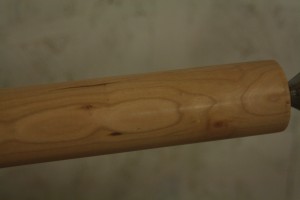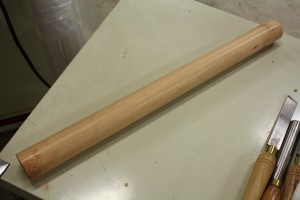A few years ago, I turned a 34″ long French rolling pin for my wife. Every year at Christmas time, she makes a traditional Slovenian pastry called potica. She got the recipe from my aunt. Making potica involves stretching dough out paper thin over the entire 5′ by 3′ kitchen table. She tried using her normal marble rolling pin, but this didn’t work very well. She thought that a French tapered pin may work better, and a really long one may work even better. So I got a 3′ long piece of 2″ x 2″ purpleheart, and turned it for her.
It works well, as long as you have room for it. It doesn’t work so well on the counter, where she likes to roll out pizza dough. So, she uses her marble pin. That is, she did, until it rolled off the counter onto the tile and broke in half.
She’s been making due with her potica pin, but I decided I’d turn her a new one that will fit a little better on the counter.
I have a couple of 8′ cherry 4×4’s that I milled on the Wood Mizer about 2 years ago. I decided to make it about 2 feet long, so I cut a piece 26″ long.
I recently got a new roughing gouge, a 1″ Benjamin’s Best from Penn State Industries. I am a fan of Benjamin’s Best tools. They are very affordable high speed steel tools. I have several, and they perform well. This gouge only cost $20.95. I decided to give it a shot over my Crown 3/4″ gouge.
Overall, this tool is quite a bit longer than my Crown rougher.
Interestingly, the flute is about 1/8″ narrower than the Crown gouge. There are two ways to measure gouges, the outer diameter, which is how the Benjamin’s Best is measured, or the European measurement, which is across the flute. Crown Tools are measured this way. This is OK with me, as I wanted a little smaller one.
I took it to the lathe without first sharpening it, as it had a fairly decent edge.
It cut pretty well, but I thought I’d touch up the edge a bit. There was a pretty noticeable difference in how well it cut. Knocking the corners off of the blank went much easier, but by the time I had it mostly round, I could tell that it was getting dull. Back to the grinder. I’ve read that the HSS used is relatively soft, and I did notice that it was softer than the Crown. But it takes an edge very well.
After it was roughed down to about 3 1/2″, I looked at the cracks that had been in the blank. As I was going to turn this down to a final diameter of 2″, I was hopeful that the cracks would get turned out.
They did. As I roughed it down to about 1/4″ over the final size, I decided to switch to my old nemesis, the skew. I’m not normally a fan of the skew, but knew this is the best tool to get a nice even diameter across the whole spindle.
It turned out pretty well.
Not too much sanding needed.
I took a small block of oak and used it as a sanding block, to make sure it sanded evenly.
I sanded it down to 400 grit, reversing it along the way to get it as smooth as possible.
Then I used some brown paper bag to burnish it.
I squared the end, reversed it, and parted it off at 25″.
It turned out pretty well.

